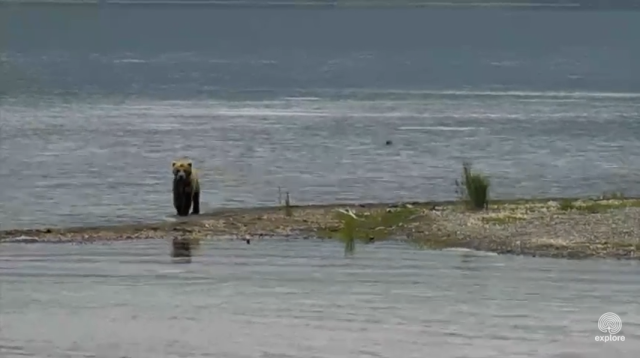While the Brooks Falls webcam at Katmai National Park is more popular and seems to have a great deal more activity on a daily basis in terms of brown bear-watching, I was determined to find some bears at the other cam, downriver at the mouth of Brooks River, at the Lower River webcam. After several days of checking in there, I finally caught a glimpse of a bear there for enough time to feel like it was worth including here. Following my previous conventions, I’ll refer to this bear as Bear G.
First, a note about the Lower River webcam. While the Brooks Falls webcam seems to focus almost exclusively on the Falls themselves, with an occasional pan to the right to see downstream a bit, the Lower River webcam covers a much wider area near the mouth of the Brooks River. It seems to pan across an almost 360-degree space, including the mouth of the river, a pedestrian bridge crossing the river, and a somewhat marshy-looking area of the river banks with taller grasses, a bit farther upriver from the mouth. Depending on the time of day and the amount of activity in each spot, the camera could be focused on any of these areas, or somewhere in between. There definitely seems to be an “operator” of some kind who monitors the camera, panning and zooming based on when there are bears or other interesting things present, and moving the camera to different views of the river from time to time.
So… around 1:15pm local time today, I saw Bear G near the mouth of the Brooks River, walking across a small strip of land at the farthest point near the river’s mouth. Bear G is light brown to dark blonde in color, with a roundish-dish-shaped face, darker fur on its legs and chest, and a darker patch of fur on the back of its neck. It seems to have a slightly short, perhaps upturned snout, and seems a bit thinner and smaller than some of the other bears I’ve seen. No other distinguishing marks were visible due to the distance. Bear G walked along the narrow strip of land, sat at the end of the point of land for a moment or two, looked around, scratched itself behind the ear in much the way you would see a domestic dog scratch itself, then turned, walked back a bit, and went into the water away from the camera and began to swim off to the left. It would stop every so often and sort of get into a standing posture, look around, then go back into a swimming posture. After swimming off diagonally to the left a bit, it turned, swam directly right back toward the land, where it eventually came out of the water further to the right from where it had gone in, and began to walk back off to the right, off camera.
It wasn’t entirely clear to me what behavior the bear was demonstrating here. It may have been foraging for fish (though it did not catch any if it was fishing), may have been looking for another bear, may have been performing some kind of recreational activity (just swimming for fun), or something else.
























 The
The 
 Bear A stayed was at the far pool the entire time, but because of the darkness it was difficult to keep track of it as it moved around in that area, so I was not able to tell if it was able to catch any fish or not.
Bear A stayed was at the far pool the entire time, but because of the darkness it was difficult to keep track of it as it moved around in that area, so I was not able to tell if it was able to catch any fish or not.

